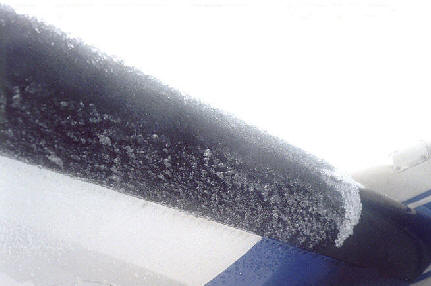
NEWSROOM
 |
NEWSROOM |
|
|
|
|
|||
|
FAA Takes Aim
At Icing With New Ice Protection Proposal
By Daniel Baxter |
||||
 |
November 24 2009
- The Federal Aviation Administration is proposing a rule requiring
scheduled airlines to either retrofit their existing fleet with
ice-detection equipment or make sure the ice protection system activates
at the proper time. For aircraft with an ice-detection system, the FAA
proposes that the system alert the crew each time they should activate
the ice protection system. The system would either turn on automatically
or pilots would manually activate it.
For aircraft
without ice-detection equipment, the crew would activate the protection
system based on cues listed in their airplane’s flight manual during
climb and descent, and at the first sign of icing when at cruising
altitude.
|
|||
|
The FAA estimates the rule would cost operators about $5.5 million to
implement. Operators would have two years after the final rule is
effective to make these changes.
The proposed rule would apply only to in-service aircraft with a takeoff
weight less than 60,000 pounds, because most larger airplanes already
have equipment that meets the requirements. In addition, studies show
that smaller planes are more susceptible to problems caused by
undetected icing or late activation of the ice protection system.
The rule technically affects 1,866 airplanes, but all turbojet airliners
and many turboprops covered under the rule already have equipment that
satisfies the requirements, and the FAA believes others will be retired
before the projected compliance date in 2012.
In August 2009, the FAA changed its certification standards for new transport category airplane designs to require either the automatic activation of ice protection systems or a method to tell pilots when they should be activated. |
||||
|
Since 1994, the FAA has issued more than 100 airworthiness directives to address icing safety issues on more than 50 specific aircraft types. These orders cover safety issues ranging from crew operating procedures in the icing environment to direct design changes. We also have changed airplane flight manuals and other operating documents to address icing safety, and issued bulletins and alerts to operators emphasizing icing safety issues.
Temperature: In some cases, airframe manufacturers have
specified definitions of icing conditions for some airplane types. In
the absence of type- specific information, the IPHWG concluded that
conditions conducive to airframe icing would exist in flight at an
outside air temperature at or below 2 [deg]C in clouds or precipitation.
Engine IPSs are commonly operated at or below a static air
temperature of 5 [deg]C or a total air temperature of 10 [deg]C. This
temperature is different from the 2 [deg]C recommended by ARAC for this
proposal. The FAA believes that using a common temperature for
activation of both the engine and the airframe IPSs would reduce crew
workload and decrease the probability of the flightcrew not noticing
when the temperature has dropped to 2 [deg]C.
The FAA therefore proposes to identify conditions conducive
to airframe icing in this proposed rule as visible moisture at or below
a static air temperature of 5 [deg]C or a total air temperature of 10
[deg]C.
The FAA agrees with the IPHWG that flightcrews must be
given a clear means to know when to activate the airframe IPS. In the
past, many airplanes have had procedures requiring activation only after
a substantial accumulation of ice. This proposed rule would require that
ice detection systems be installed, or that ice protection systems be
manually activated in conditions conducive to icing in most phases of
flight. In the cruise phase, the airframe IPS would be activated at the
first sign of ice accumulation anywhere on the airplane. To ensure
timely activation of the airframe IPS, the FAA proposes to amend the
current part 121 regulations as recommended by the IPHWG, except for the
change to the temperature considered conducive to airframe icing, as
discussed above. Compliance Time: This notice proposes a two-year compliance time after the effective date of the final rule. That compliance time is based on the time required to approve new designs and install new equipment. For some airplanes, it may be possible to comply through AFM revisions alone, which could be accomplished quickly. However, some airplanes may need to go through a more involved certification process, so the longer compliance time of two years was chosen. |
| ©AvStop Online Magazine Contact Us Return To News |